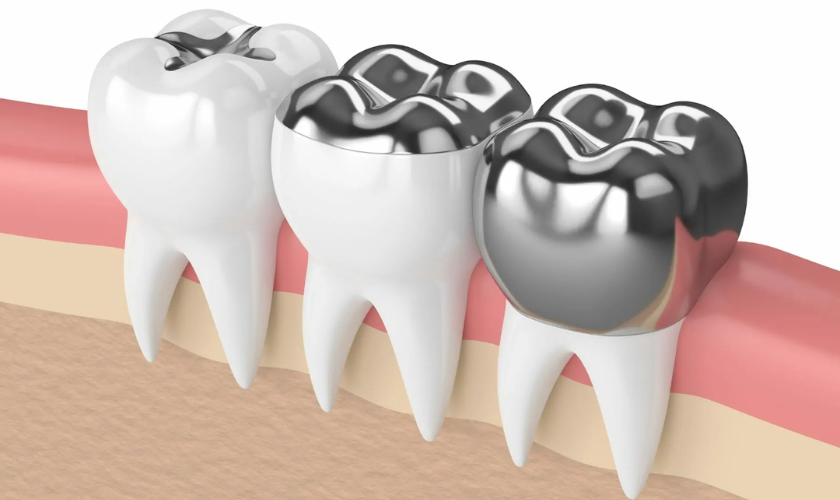
Amalgam fillings have been a staple of dental care for over a century, offering a durable and cost-effective solution for restoring teeth affected by decay. Despite their widespread use, there often needs to be more clarity and concern surrounding these silver-colored fillings. In this comprehensive guide, we'll delve into everything you need to know about amalgam fillings, from their composition and application to their benefits and potential drawbacks.
What Are Amalgam Fillings?
Amalgam fillings, also commonly known as silver fillings, are one of the oldest and most traditional materials used in dentistry to restore teeth affected by decay. They have stood the test of time, dating back to the early 19th century, and continue to be widely used today due to their durability and affordability.
Composition of Amalgam Fillings
Amalgam fillings consist of a blend of metals carefully selected for their specific properties:
- Silver: The primary component of amalgam fillings, silver provides strength and durability to the restoration. It also contributes to the material's resistance to wear and corrosion.
- Mercury: Despite being a cause of concern for some, mercury is a crucial ingredient in dental amalgam. It acts as a binder, holding the other metals together and enabling the mixture to be shaped and manipulated during placement. It also facilitates the setting process, allowing the filling to harden and become stable.
- Tin: Tin is added to amalgam fillings to enhance the setting reaction and improve the material's resistance to corrosion. It contributes to the overall strength and longevity of the restoration.
- Copper: Copper is included in the amalgam mixture to increase its strength and durability. It helps to reduce the expansion and contraction of the filling over time, minimizing the risk of cracks or fractures in the tooth.
Properties of Amalgam Fillings
Strength and Durability: Amalgam fillings are renowned for their exceptional strength and durability, making them suitable for use in both small and large cavities. They can withstand the forces of chewing and grinding, providing long-lasting protection for the tooth.
Ease of Placement: The pliable nature of dental amalgam allows dentists to shape and pack the material into the prepared cavity easily. It ensures a precise and secure fit. This ease of placement makes amalgam fillings a convenient option for restoring decayed teeth.
Biocompatibility: Despite containing mercury, dental amalgam is considered biocompatible and generally well-tolerated by the vast majority of patients. Once set, the mercury in the filling becomes chemically bound to the other metals, minimizing the risk of exposure.
Cost-Effectiveness: One of the most significant advantages of amalgam fillings is their affordability. They are typically less expensive than alternative materials such as composite resin or porcelain, making them accessible to a wide range of patients.
Application Process
Preparation: This involves the careful removal of any decayed or damaged tooth structure using specialized dental instruments. The dentist will use drills, excavators, or other tools to clean out the decay and create a clean, stable foundation for the filling.
Isolation: Once the tooth is prepared, the dentist may isolate the area to prevent moisture contamination during the filling placement process. Rubber dams or cotton rolls may be used to keep the tooth dry and free from saliva, blood, or other fluids that could interfere with the bonding of the filling material.
Mixing: The next step involves the meticulous mixing of the dental amalgam to achieve the desired consistency and properties. The dentist Hayden carefully measures the appropriate amounts of mercury and alloy powder according to the manufacturer's instructions. The mixture is then thoroughly mixed using a spatula or amalgamator until it reaches a uniform color and texture.
Placement: With the filling material prepared, the dentist begins the placement process. The mixed amalgam is packed into the prepared cavity using specialized instruments such as condensers or pluggers. The dentist works methodically to ensure that the filling material fills the cavity and adapts to the tooth's contours.
Finishing and Polishing: After the filling has been shaped and contoured, the dentist will perform final finishing and polishing to create a smooth surface texture. This helps to enhance the aesthetics of the restoration and minimize rough areas where plaque and bacteria could accumulate.
Benefits of Amalgam Fillings
Durability and Longevity
One of the primary advantages of amalgam fillings is their exceptional durability and longevity. Amalgam is a robust material that can withstand the forces of chewing and grinding, making it suitable for use in both small and large cavities. With proper care and maintenance, amalgam fillings can last for many years, providing reliable protection for the restored tooth.
Cost-Effectiveness
Amalgam fillings are typically more affordable than alternative materials such as composite resin or porcelain. This makes them a cost-effective option for patients seeking dental restorations, particularly for those with limited financial resources or those without dental insurance coverage. The affordability of amalgam fillings ensures that patients can access quality dental care without breaking the bank.
Versatility
Amalgam fillings are highly versatile and can be used in various locations in the mouth, including the back teeth (molars and premolars). They are suitable for filling cavities of different sizes and shapes, making them a versatile option for addressing a wide range of dental concerns. Additionally, amalgam fillings can be placed in areas with high levels of moisture or where isolation may be challenging, thanks to their ability to sit in a wet environment.
Amalgam fillings have been a cornerstone of dental care for decades, providing a durable and cost-effective solution for restoring decayed teeth. While concerns about mercury content and aesthetics persist, numerous studies have affirmed the safety and efficacy of these dental restorations. Ultimately, the decision to choose amalgam fillings should be made in consultation with your dentist, taking into account your individual needs and preferences.
